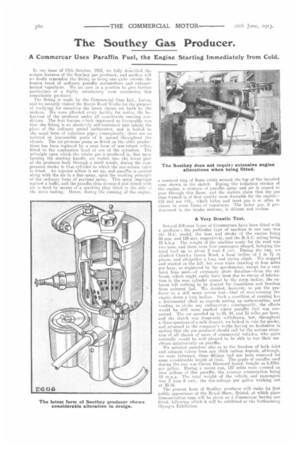The Southey Gas Producer.
Page 4

If you've noticed an error in this article please click here to report it so we can fix it.
A Commercar Uses Paraffin Fuel, the Engine Starting Immediately from Cold.
In our issue of 17th October, 1912, we fully described the unique features of the Southey gas producer, and readers will no doubt remember the•fitting as being one quite outside the beaten track of ordinary paraffin carburetters and exhaustheated vaporizers. We are now in a position to give further particulars of a highly satisfactory issue. concerning this remarkable producer. The fitting is made by the Commercial Cars Ltd., Lutou, and we recently visited the Bisc.ot Road Works for the purpme of verifying for ourselves the latest claims set forth by the makers. We were afforded every facility for noting the behaviour of the producer under all conceivable running conditiens. The first feature iellich impressed us favourably was that, the fitting is an absoltreely self-contained unit taking the place of the ordinary petrol carburetter, and is bolted to the usual form of induction pipe; consequently, there are no isolated or inaccessible parts of it spread throughout the chassis. The air-pressure pump as fitted on the elder productions has been replaced by a neat form of nor-return velve, fitted to the combustion head of one of the cylinders. The principle upon which the intake gas is produced is, that upon turning the starting handle, air rushes into the lower part of the producer body through a small nozzle, during the compression stroke in that cylinder to which the non-return valve is fitted. An injector action is set up, and paraffin is carried along with the air in a fine spray, upon the working principle of the ordinary form of perfume spray. This spray impinges against a baffle, and the paraffin thus atomized and mixed with air is fired by means of a sparking plug fitted to the side ef the main casting. Hence, during the running of the engine,
a constant ring of flame exists around the top of the inverted cone shown in the sketch. During the induction strokes of the engine, a mixture of paraffin spray and air is caused to pass through this flame, and the makers claim that the gas thus formed is of that quality most. desirable for the engine— CO and not CO2, which latter and inert gas is so often in excess in some forms of vaporizers. The latter gas, if predominant in the intake mixture, is diluent and useless.
A Very Drastic Test.
Several different types of Coeamercars have been fitted with a producer; the particular type of machine in our case was the M.C. model, the bore and stroke of the engine being 95 mm. and 120 mm. respectively, and the R.A.C. rating being 22 b.h.p. The weight of the machine ready for the road was two tons, and there were four passengers aboard, bringing the total load up to about 2 tons 6 cwt. During the run, we climbed Crawley Green Road, a local incline of 1 in 71 in places, and altogether a long and trying climb. We stopped and started on the hill, but even when crawling at four miles per hour, as registered by the speedometer, except for a very faint blue mist—of extremely short duration—from the exhaust, which might easily have been due to excess of lubrication in the rear cylinder caused by the steep incline, the exhaust left nothing to be desired for cleanliness and freedom from unburnt fuel. We decided, however, to put the producer to a still more revere test—that of over-running the engine down a long incline. Such a condition of running has a detrimental effect as regards setting up carbonization, and tending to choke any carburetter; consequently, the effects would be still more marked where paraffin fuel was concerned. The car speeded up to 23, 24, and 25 miles per hour, and the clutch was frequently withdrawn, but, throughout a three-quarters-of-a-mile descent., we looked in vain for smoke, and returned to the company's works having no hesitation in stating that. the gas producer should call for the serious attention of all classes of users of commercial vehicles, who quite naturally would be well pleased to be able to run their machines satisfactorily on paraffin.
We satisfied ourselves also as to the freedom of both inlet and exhaust valves frormany thick carbon deposit, although, we were informed, these fittings had not been removed for some considerable length of time. The grade of paraffin used during the run %%as Crown Diamond brand, bought at 6.375d. per gallon. During a recent run, 137 miles were covered on nine. gallons of this paraffin, the average consumption being 15 m.p.g. The total weight of the vehicle and passengers was 3 tons 6 cwt., the ton-mileage per gallon working out at 50.16.
The present form of Southey producer will make its first public appearance at the Royal Show, Bristol, at which place demonstration runs will be riven on a Commercar having one fiti ed, following which it will be exhibited at the forthcoming Olympia Exhibition.
































